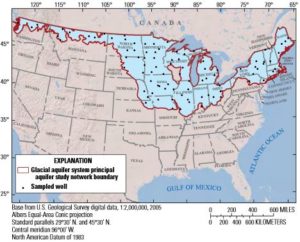
Last week, we talked about groundwater availability in the principle aquifer of the Glacial Aquifer System. Today, we are here to talk about the quality of the groundwater found within the Glacial Aquifer system, which stretches across 25 states (the principle aquifer, where Indianapolis gets groundwater from, stretches across 22 states). The USGS conducted another interesting study to investigate this by sampling 90 public supply wells across the system, with two in Indiana and one along the Indiana and Ohio border.
The USGS found very low concentrations of organic constituents within the aquifer, which is very good. Organic, or carbon-containing, constituents come from human activities such as the chemicals and processes used in household, business, industrial, and agricultural activities.
The USGS also looked at inorganic, or non-organic, compounds which generally are synthesized by purely geologic systems. Human activities like agriculture can pollute groundwater with inorganic chemicals such as nitrates, but often inorganic constituents “naturally” enter groundwater due to leaching bedrock and other processes. The USGS found that 51% of the study area had low to no inorganic constituents, 23% had moderate inorganic constituents, and 26% had high inorganic constituents.
If you are interested in reading more about water quality within the Glacial Aquifer System, the report is available for download from the USGS.
